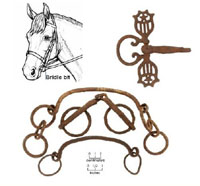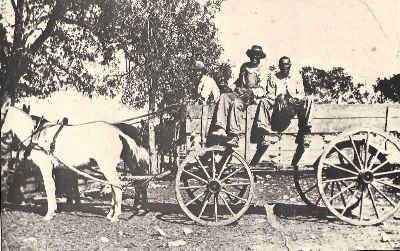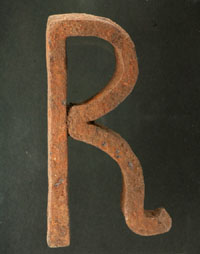
The letter "R" is a remant of Ransom Williams branding iron, used to mark his horses as his property.  |
|
 This metal “R” is part of Ransom Williams’ livestock brand. The letter has broken off of the branding iron and part of the shank, the shaft connecting the brand to the handle, can be seen on the backside. The letters “RA” were registered to Ransom Williams in April of 1872 as his horse brand according to the Travis County Register of Marks and Brands from that year. This metal “R” is part of Ransom Williams’ livestock brand. The letter has broken off of the branding iron and part of the shank, the shaft connecting the brand to the handle, can be seen on the backside. The letters “RA” were registered to Ransom Williams in April of 1872 as his horse brand according to the Travis County Register of Marks and Brands from that year.
The horses and mules may have pulled wagons filled with large wooden barrels, an especially important job at the Williams farm. Archeologists found more than 40 pieces of metal barrel hoops at the site. These metal strips held together the wooden boards, or staves, that make up a barrel. 
Some of the hoops show the machine-cut ends and rivets that fastened the band into a large circle. Others are crudely cut and repaired by hand indicating that Ransom made his own repairs to continue using a broken hoop. Since they did not have running water in the cabin, or even a water well, the Williams may have used barrels to haul water from nearby Bear Creek for daily use. Water was a critical resource for the family and the livestock on the farm. |
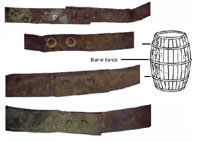
Fragments of metal barrel hoops found at the farm are shown with a drawing of a wooden barrel. Barrels were important to the Willaims family, as they likely were used to haul water.  | |
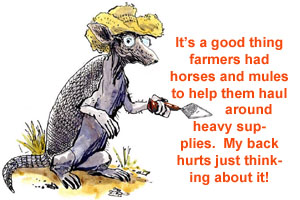
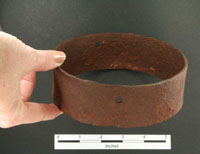
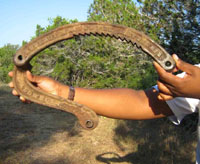
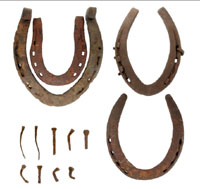
 Horseshoes, muleshoes and horseshoe nails of various sizes suggest that Ransom Williams not only raised horses for his own use, but may have also raised and trained horses for others. Mules were probably employed for the heavier work around the farm such as hauling and plowing, since horses were considered far more valuable and are more prone to injury than mules. The metal “shoe” helps protect the hooves of horses and mules which are made of material similar to human fingernails but much thicker. The nails are driven through small holes in the shoe and into the hoof. Archeologists found a total of 13 horsehoes and 2 muleshoes. Muleshoes are typically larger than horseshoes and are shaped differently.
Horseshoes, muleshoes and horseshoe nails of various sizes suggest that Ransom Williams not only raised horses for his own use, but may have also raised and trained horses for others. Mules were probably employed for the heavier work around the farm such as hauling and plowing, since horses were considered far more valuable and are more prone to injury than mules. The metal “shoe” helps protect the hooves of horses and mules which are made of material similar to human fingernails but much thicker. The nails are driven through small holes in the shoe and into the hoof. Archeologists found a total of 13 horsehoes and 2 muleshoes. Muleshoes are typically larger than horseshoes and are shaped differently. 